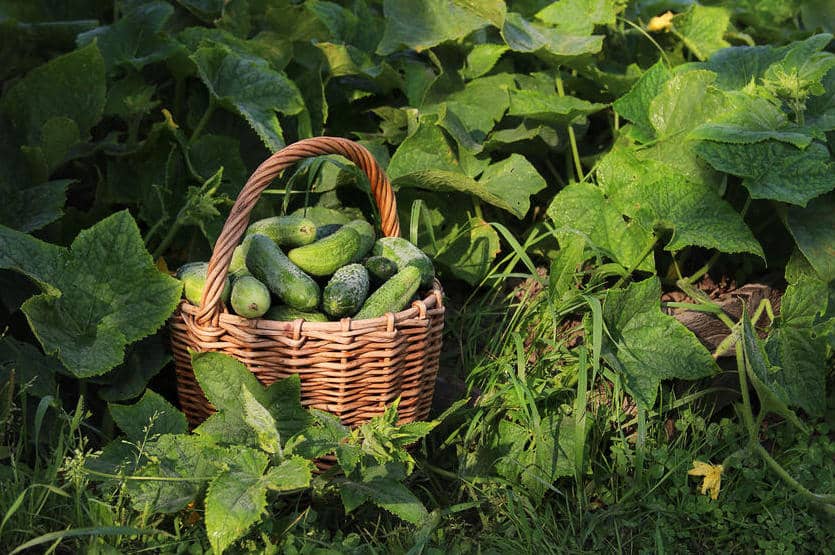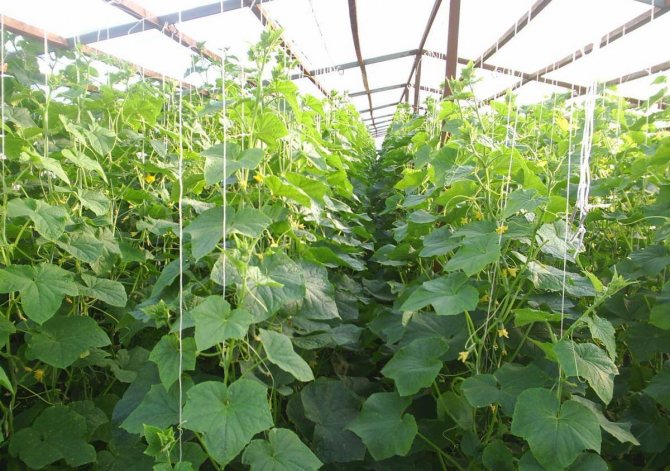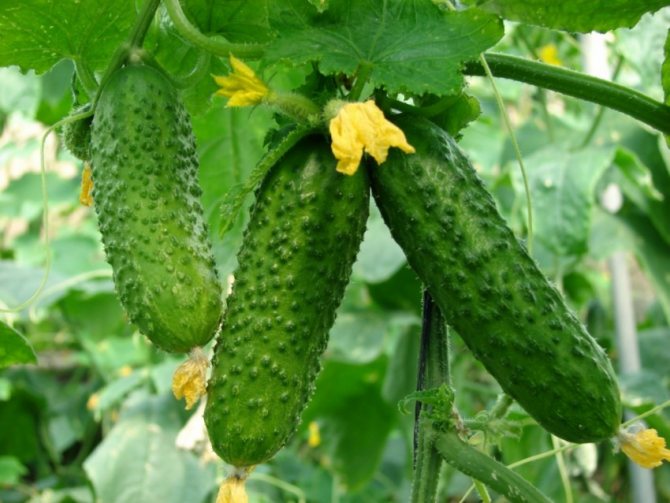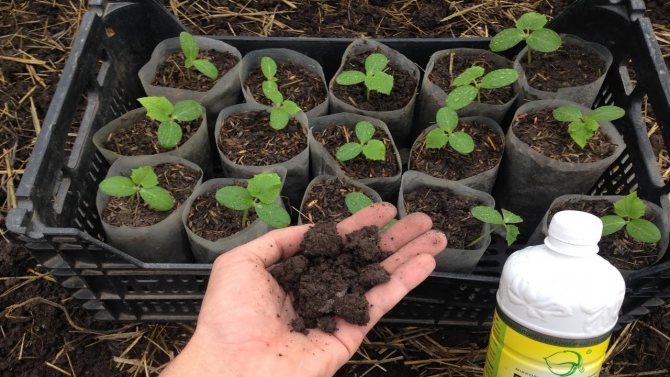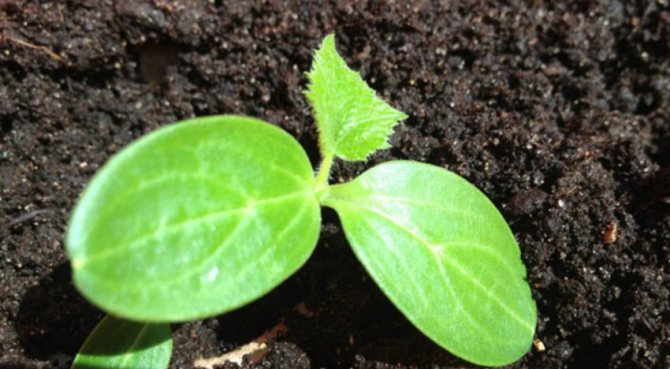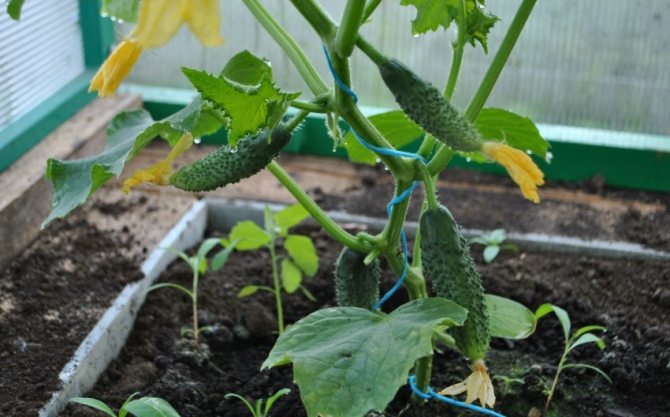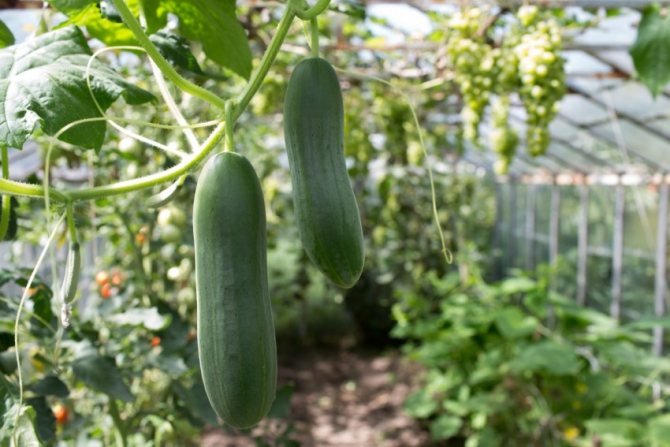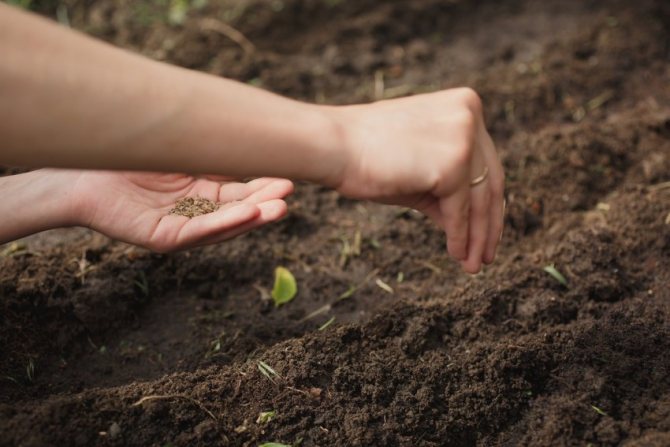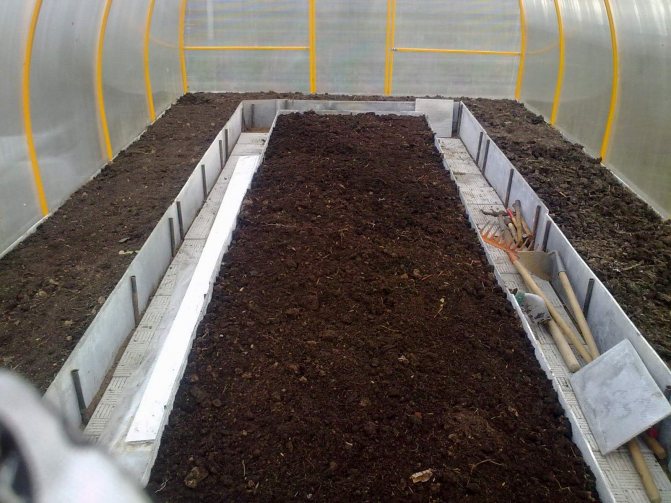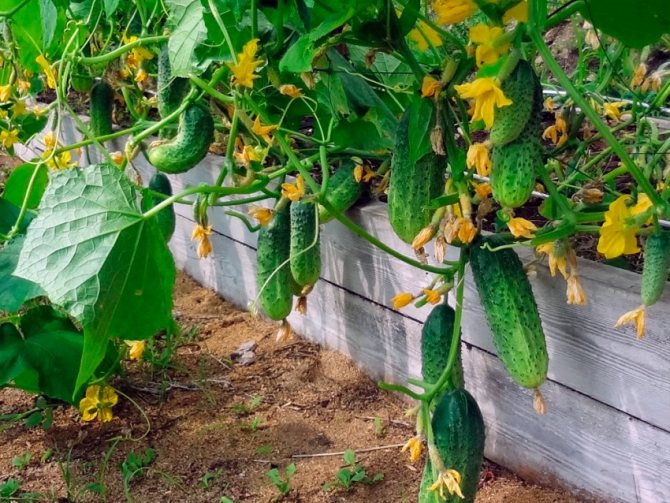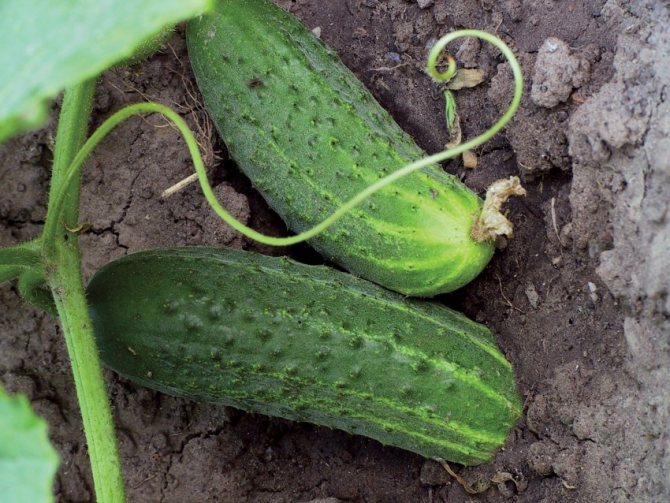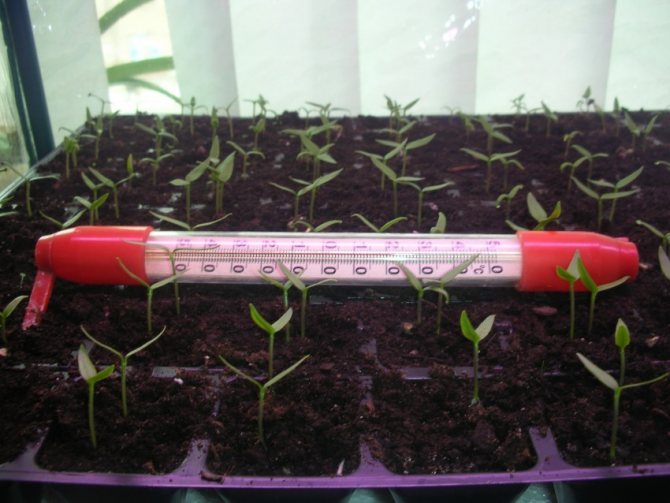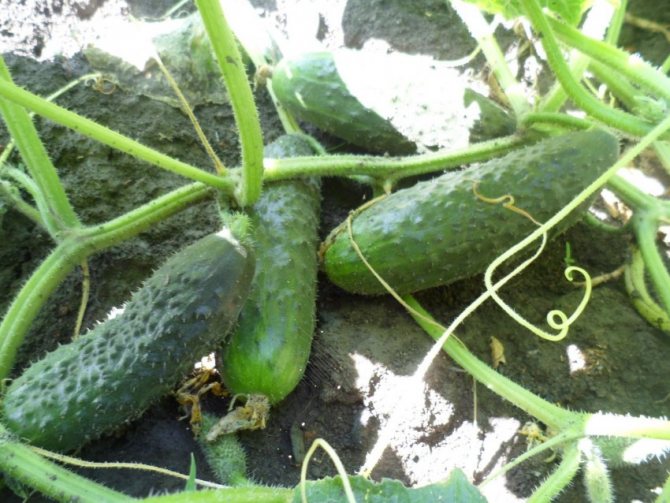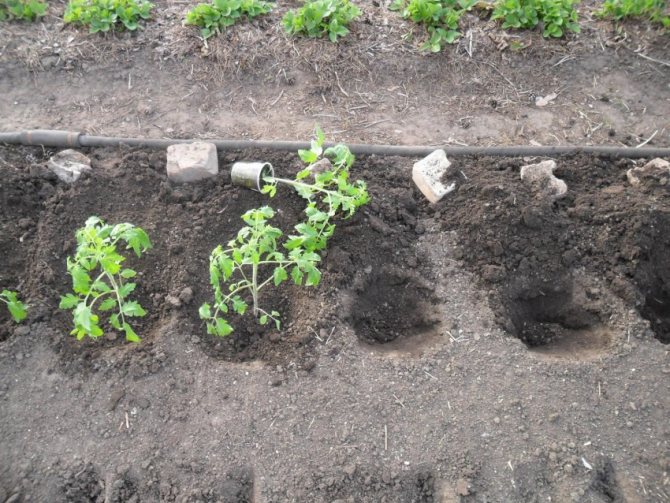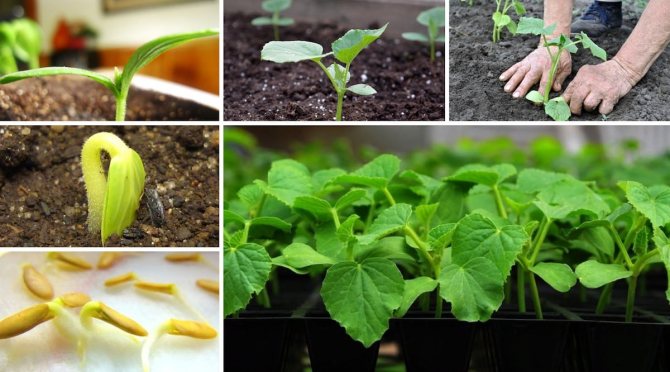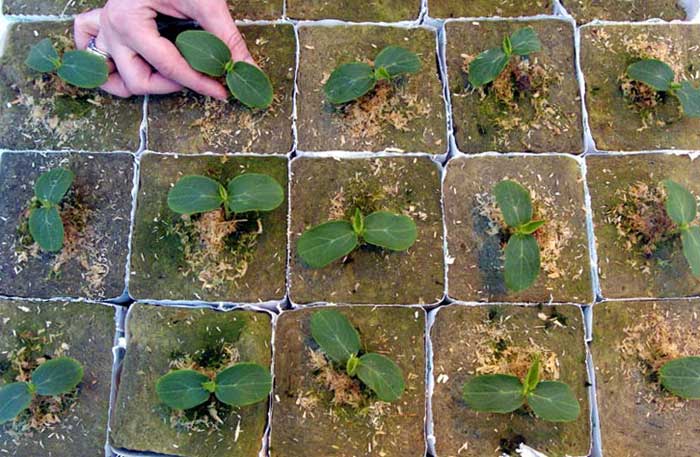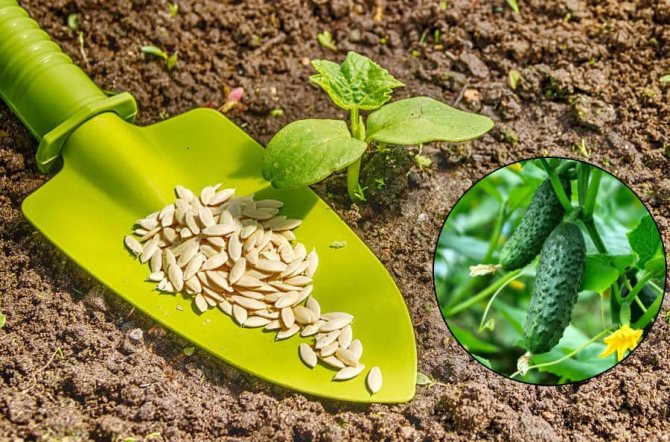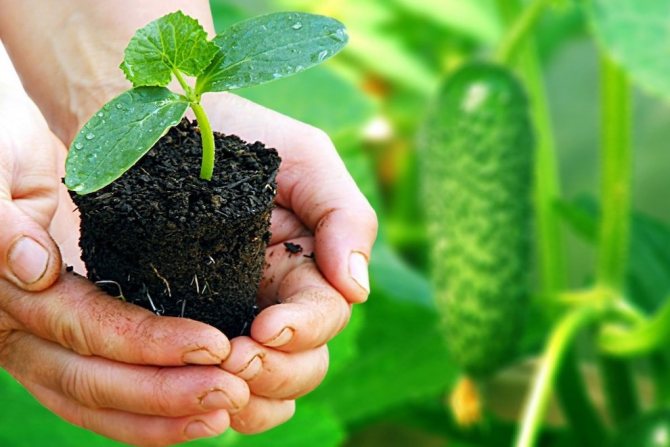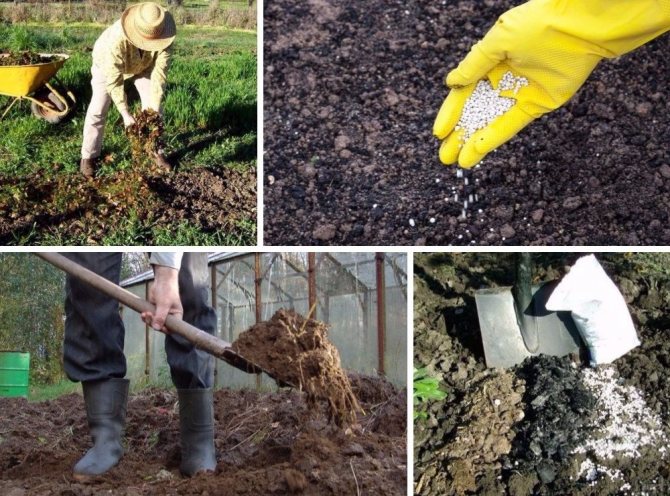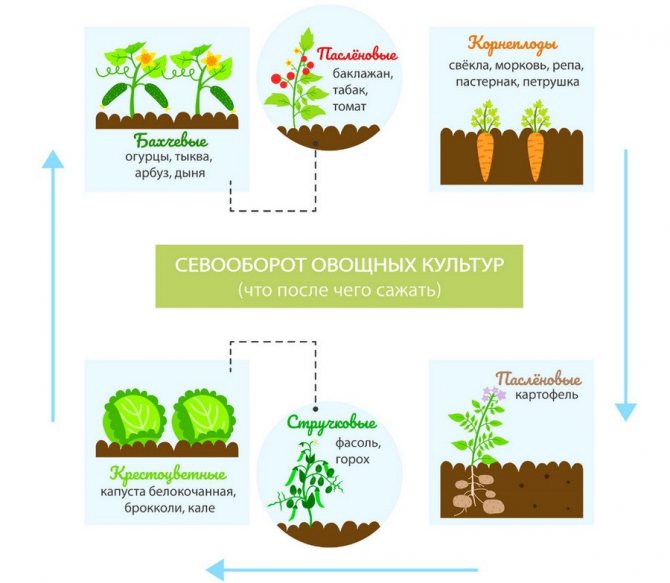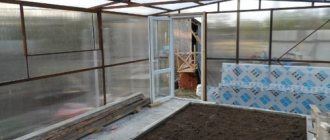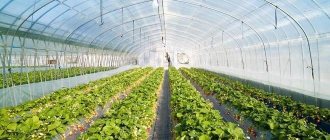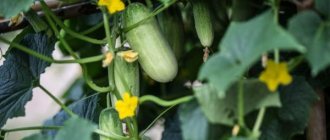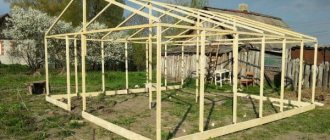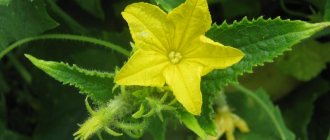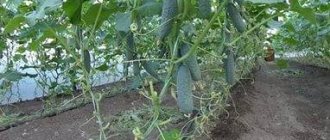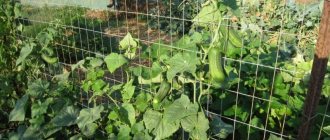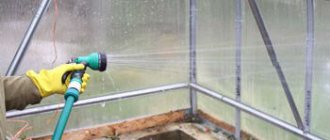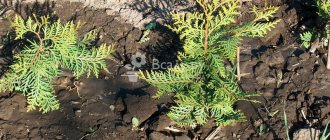What kind of land do cucumbers like?
The main requirements of the culture for the mechanical composition of the soil are high air permeability and moisture capacity, therefore, cucumbers are recommended to be planted on light and medium loams, which are distinguished by good aeration of the root system, evenly distribute and retain moisture.
For good development, a cucumber needs mineral and organic nutrition, which comes from the soil immediately after planting the plants, so the soil should be high in humus and with an optimal ratio of macronutrients.
Important minerals:
- Nitrogen. With its lack, the growth of the aboveground part, the development of roots, slows down.
- Potassium. Deficiency of the mineral weakens plants, reduces resistance to disease and cold.
- Phosphorus. With a shortage, plant growth and fruit formation slows down.
- Magnesium. Leaves turn yellow, become brittle, fall off. Plant growth and fruit development slows down.
The culture is demanding on the reaction of the soil solution and does not tolerate acidification. The optimum acidity level is pH 6.2-6.8.

Cucumbers love warm soil. Planting seedlings and planting seeds is possible only after warming up the soil to t 18 ° C. With a decrease in t to 14-15 ° C for 3-5 days, the roots of the cucumber cease to develop.
This can lead to the death of plants. Surviving cucumbers will be weak and prone to disease. The yield will be greatly reduced.
Cucumbers develop better if the soil is 2-3 ° C warmer than the air. Average daily t of air for a cucumber is 16-32 ° C. These indicators are also used for ground control.
Soil moisture should be 75-85%. In the future, to control the moisture content of the soil, a handful of earth is taken from the root layer and squeezed tightly in a fist. If water comes out, the humidity level is over 80%. If the lump retains fingerprints, the humidity is over 70%. The lump crumbles - less than 60%.
The preparation of the soil and the arrangement of the beds for the greenhouse and open ground are the same. The only difference is in the preparatory work.
Greenhouse processing
Most gardeners do not have the opportunity to observe crop rotation in the greenhouse, therefore, after harvesting, the depleted soil with manure rotted over the summer is completely removed from the premises and distributed in the place of future beds. An exception is the planting sites for pumpkin crops.
If for some reason a complete replacement of the soil is impossible, it must be disinfected.
The options are:
- Spilling the soil with boiling water and covering the surface of the bed with a film for a day. After that, the earth is dug up and harrowed. The procedure is repeated after 3 days. Held in the spring.
- Application of biofungicides. Spraying on the soil solutions of drugs: Trichodermina, Fitosporin M, Phytocide, Bordeaux mixture, Pentafoga. They are processed in autumn and spring.
- Adding bleach 200 g per 1 sq. m. and digging up the soil. Apply 6 months before planting cucumbers.
- Spilling the soil with 2% formalin solution (40%), cover the surface with a film for 3 days. The soil is dug up and harrowed. The event takes place 2-4 weeks before planting.
From autumn all plant residues are collected and burned. The inner surfaces of the greenhouse are washed with 2% formalin solution (40%). It is advisable to fumigate the greenhouse with sulfur.
Open ground
In the open field, you need to constantly change the place for growing cucumbers, returning the culture back only after 3-4 years. The best predecessors are tomatoes, cabbage, peas. Do not plant after pumpkin crops.
A place for a garden bed is selected well-lit, protected from drafts and cold northerly winds. In the fall, the site is dug up, removing all plant waste.
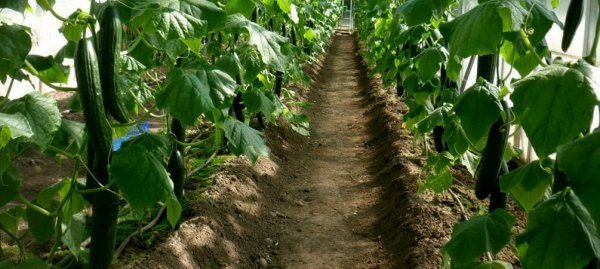

In the greenhouse and in the open field, when there is no soil replacement, green manure plants can be sown. The best option is white mustard. It must be sown immediately after harvesting the cucumber plants. After 3-4 weeks, a sufficient vegetative mass is formed, which is embedded in the soil to the depth of a shovel bayonet.
Mustard will destroy and remove from the soil most of the root secretions of cucumbers that have accumulated over the season.
In addition, a kind of compost is obtained in the soil, rich in proteins and minerals. A system of root canals is created in the soil, which improves its mechanical properties.
Dead mustard roots attract worms and microbes, which form nitrogen during their life. Additionally, the soil is protected from erosion and swelling.
In the video, the author shows his method of preparing the soil and beds for sowing cucumbers.
Arrangement of the garden
Cucumber is one of the few plants that can and even be grown on fresh manure. When laying manure, it must be borne in mind that the root layer of plants reaches a depth of 20 cm. Therefore, on the surface of the manure there should be a 25-30 cm layer of fertile soil.
In such a bed of a thermophilic culture, cooling of the roots with a strong decrease in air temperature at night or insufficient heating of the soil with early planting in greenhouses is not terrible.
To equip the beds in the selected area, mark its boundaries. The width should be such that the gardener can freely reach the plants with both hands. It is impossible to lean even on the boards spread on top of the beds. The cucumber does not tolerate the slightest soil compaction.
A trench 50-60 cm deep is dug over the area of the garden bed. In the spring, two weeks before planting, it is filled with fresh manure. Top covered with garden soil and fertilized.
If it is very cold, the bed is covered with a film for intensive heating. Such a measure is mainly needed only in unheated greenhouses and regions with late summer onset.
Fertilizers for cucumbers begin to be applied two weeks before transplanting seedlings or planting seeds.
For 1 sq. m. of the cucumber ridge are introduced:
- rotted manure 25 kg or compost 10 kg;
- superphosphate 40 g;
- potassium sulfate 40 g;
- magnesium sulfate 15 g or potassium magnesium 60 g.
Fertilizers are evenly scattered on the soil surface, the ridge is dug up. After that, water is spilled at a rate of 10 liters per 1 sq. m.
After a week, add 30 g of ammonium nitrate per 1 sq. m. The bed is re-dug up and spilled with water. After that, we can assume that the soil is completely ready for planting cucumbers.
The stages of soil preparation should not be neglected. This is one of the most basic agricultural techniques that helps eliminate parasites and fungal spores. The fact is that most of the harmful microorganisms settle and even survive frosts in the upper layer of the soil. When loosening, digging up the soil, the habitual habitat of parasites is destroyed, and they die.
Did you know? If you rub the bathroom mirror with fresh cucumber pulp, it won't fog up.
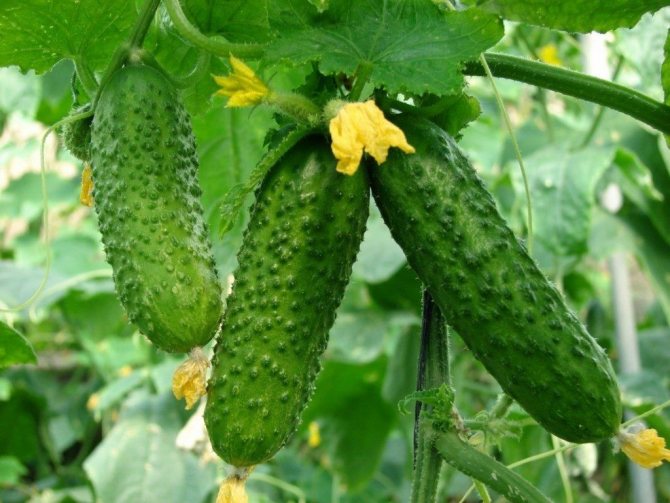

In addition to the disinfection nature, soil preparation works have the goal of enriching them with nutrients. During the season, the soil is depleted, so the plants will simply have nothing to eat during the period of active development. As a result, the crop will be scarce and will lose a lot in quality.
At the time of soil preparation, the acidity level is determined.This point is also very important, since cucumbers will not bear fruit in an acidic environment. The optimum value should be between 5 and 7 pH. If the acidity level does not correspond to the specified value, then it is corrected by adding deoxidizers or elements, on the contrary, increasing acidity. Determination of soil acidity using litmus paper
Soil structure is another important indicator that affects the growth and development of cucumber crops. Plants bear poor fruit on heavy clay soils. If there is such a soil on the site, then it is necessary to carry out work in advance to improve its structural composition by introducing sand, peat and other substances that impart friability.
When cultivating cucumbers in greenhouses, you need to carefully approach not only the preparation of the soil, but also the structure itself. Regardless of whether a portable greenhouse is on the site or stationary, the walls of the room must be disinfected. Profiles, polycarbonate / foil are subject to processing. Outside, the structure is washed with chlorine-containing substances. You can use the usual whiteness. It is diluted with water in a ratio of 1:10.
Before proceeding with the processing inside the premises, it is necessary to remove it, take out all garden tools, boxes, etc. The simplest option is to use smoke bombs "Peshka-S".
The checkers are placed at an equal distance from each other around the entire perimeter of the greenhouse, and then the wick is set on fire, starting from the farthest from the door. Then the room is sealed. If it is equipped with ventilation, then it must be turned off. In a sealed state, the room is left for 8-10 hours.
After processing, ventilate the greenhouse for 2 weeks
It is also possible to treat internal surfaces from a spray tank. For liquid treatments, you can use a 3% solution of copper sulfate or "Fitosporin" (diluted in a ratio of 5:10). You can also use "Fundazol" (30 g per 10 liters of water).
Important! When carrying out disinfection treatments inside the greenhouse, be sure to use protective equipment for the eyes and respiratory tract. Clothes should be selected tightly to the body, with long sleeves and a high collar.
In the autumn
The main problem of the greenhouse is the relatively small area of food for plants. In this regard, it is not always possible to comply with the rules of crop rotation. In the case of a mobile structure, you can simply rearrange it to another place, having previously prepared the site in the usual way. In the case of a stationary greenhouse, a partial or complete change of soil is carried out.
With a partial change of soil, immediately after harvesting, the premises are disinfected. The soil is dug onto a shovel bayonet, and then sprinkled with a layer of bleach. The rest of the work is carried out in the spring.
In shelving greenhouses, a complete change of waste soil is carried out in the fall. In empty boxes, first a layer of 10 cm of cow dung is placed, then a layer of soil of the same thickness is placed. After 3-5 days, add a layer of soil (15 cm).
In the spring
In the spring, a 10–20 cm layer of soil is removed. The site is dug to a depth of 25 cm.
To increase the fertility of plants, the following manipulations are carried out in greenhouses in spring:
- In place of the removed soil layer, 30–40 cm of manure is laid.
- Depressions are formed in it at equal distances.
- 1 liter of boiling water is poured into the recesses - this is necessary to activate the decay process, which will contribute to the release of heat.
- After 5 days, a mixture of turf soil, sawdust, sand and humus (2: 1: 1: 2) is laid on top of the manure.
Preparing the ridges for planting cucumbers
Cucumbers love the sun and nutritious soil, so it is recommended to set aside a well-lit area for them, where corn, cabbage, peas, and beets were grown a year ago.
- Given the fact that this culture is thermophilic, warm beds are arranged in cold regions.In the fall, the site is dug up, removing the roots of weeds. Then plant residues, fresh manure are spread on the designated place. A layer of fertile soil is poured on top. In this state, the ridge should overwinter.
- The day before the proposed sowing, the surface layer is loosened, the soil is spilled with hot (85-90 degrees) water, dissolving copper sulfate in it. Spend 1 tsp. preparation for 10 liters. For each square meter, 3 liters of solution are needed. Cover the ridge with a film. Such processing will provide ideal conditions for the cucumbers.
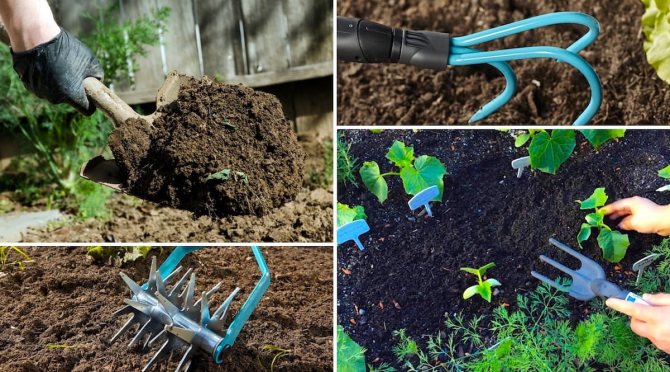

The right soil for cucumbers is the key to a successful harvest
Important! If the beds are prepared without a layer of manure and organic matter, then during spring digging, the lightest sandy loam or loose loamy soil is chosen and rotted compost is added. In this case, it is advisable to orient the ridges in the direction from south to north.
How to prepare the soil for planting under cucumbers
Untreated soil in the greenhouse will not cause significant harm to cucumber plantations, however, one should not expect a large harvest. Infections or pests left over from the last season can infect the fruits on the bushes. Moreover, if the composition of the soil or its acidity turns out to be unsuitable for growing cucumbers, then the seeds may not even hatch.
Preparation in the fall consists of a set of measures aimed at changing its composition and structure according to the requirements of each plant. First, let's figure out what exactly is good for cucumbers. With all the agronomic knowledge, you can choose to create all the necessary conditions for growing this vegetable.
Read about the best varieties of tall tomatoes for greenhouses at the link.
Soil requirements
The root system of cucumbers is very weak - one main root, delicate and fragile. Therefore, the fruits in winter require a loose loamy soil in which it will be easy for him to gain a foothold. An equally important indicator is acidity. The soil should be neutral or, in extreme cases, slightly acidic with a pH of no more than 7 units.
Read the preparation of the greenhouse in the fall for tomatoes here.
Predecessors
In some cases, other vegetable crops can partly prepare the soil for you. If you correctly alternate different vegetables and do not plant the same plants for more than 2-3 years in a row. Compliance with crop rotation allows you to ensure the preservation of the soil structure, and also prevents the transmission of diseases such as late blight.
Cucumbers should not be planted after similar plants such as zucchini, melons (watermelons, melons), pumpkins. Planting after nightshades is also unfavorable, especially after the tomatoes were planted in a polycarbonate greenhouse. They will grow well after early maturing white cabbage, root vegetables or peppers.
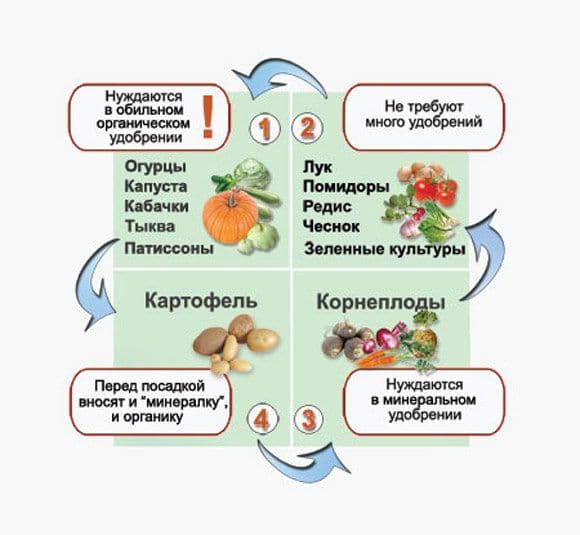

Soil preparation before planting crops crop rotation
Fertilization of fruits usually occurs in September. You can produce it in the spring, but then humus will not provide heating of the soil and planting will be postponed indefinitely. We start this business after the harvest is harvested and the greenhouse is cleaned and disinfected. Check the condition of the structures, it is much easier to fix all the problems before sowing.
Fertilizer placement procedure:
- remove last year's soil to a hard sandy-loamy layer;
- put some branches on the bottom of the beds (you can use cut shoots of bushes and fruit trees);
- sprinkle such a "frame" with black soil;
- pour out manure at the rate of 1 bucket per square meter;
- place as much compost and humus as you can mix with last year's soil (shake it well to remove the roots of the weeds);
- the top layer should be 1: 1 of humus and ordinary loose sandy soil.
This layer cake will be a great help for growing cucumbers.Try to make sure that the prepared soil does not freeze during the winter. To do this, cover it with snow, this method will help and moisten the beds in the spring.
Liming
As already mentioned, cucumbers need neutral or slightly acidic soil. Liming the soil is necessary at an increased pH. If the pH is too high, then you will have to work with the chemical composition of your beds. Liming the soil will help you. The easiest and most affordable way is to scatter quicklime 200 g per meter.
In boxes and barrels
The limited space of boxes, barrels or other containers requires a slightly different approach to the composition and preparation of the soil.
When using barrels and other tall containers:
- a layer of pebbles, broken brick, strong branches for 1/3 of the container is laid on the bottom;
- hay, sawdust and tops are placed on top, sprinkled with humus or rotted manure - after laying this layer, 40 cm remains to the edge of the container;
- spill with EM preparations for better overheating;
- mix leafy earth and humus (1: 1) or peat and humus (1: 1);
- fall asleep with a 20 cm layer.
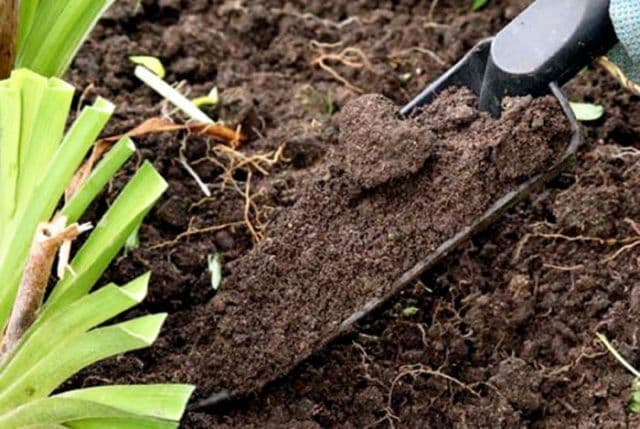

The container is covered with foil and left to refill for two weeks. Fertile soil is poured so that 15 cm remains to the edges of the sides of the container. Two weeks before planting, the soil is fertilized for cucumbers.
On balconies and window sills, cucumbers are grown in containers with a volume of at least 5-7 liters (depending on the variety). At the bottom of the pots there must be holes for water drainage and a drainage layer 5 cm high.A layer of fertile soil at least 20 cm.
For growing cucumbers in containers, ready-made and homemade soils recommended for seedlings are well suited. They are high in nutrients, which is especially important when the root environment is limited.
Cultivated plants, including cucumbers, remove almost all nutrients from the soil during the season. She is depleted. Salinity, increased acidity and severe drought drastically reduce the level of soil bacteria, and hence the formation of humus, so the soil must be monitored constantly, not limited to seasonal fertilization.
In the spring
You can also do with the standard option of replacing the soil layer with a fertile substrate consisting of sod soil, peat, sand and humus with field soil (2: 1: 1: 1). A number of mineral components are immediately added to this composition:
- 15 g of potassium sulfate;
- 20 g superphosphate;
- 10 g of ammonium nitrate.
Did you know? In ancient Rome, cucumbers were used as a remedy for scorpion bites. The victim was sure to introduce them into the diet and apply the rings of the fetus to the affected area.
The soil on the site begins to be prepared in the fall, and this work continues in the spring. To begin with, select a site well-lit by the sun, without a draft. When choosing an area for cucumbers, the rules of crop rotation are taken into account. The culture is not planted after:
- zucchini;
- squash;
- eggplant;
- tomatoes;
- potatoes.
In autumn
At this stage, the area is first cleared of plant residues, the roots must be removed. All vegetation collected on the site is burned. Then the ash from the fire can be used as a disinfectant and fertilizer.
Then deep cultivation is carried out. This can be done with an ordinary shovel, digging onto a bayonet. This method of cultivation is suitable if there is a loose, light soil on the site. Heavy soils need to be dug to a great depth (40 cm). This requires a cultivator.
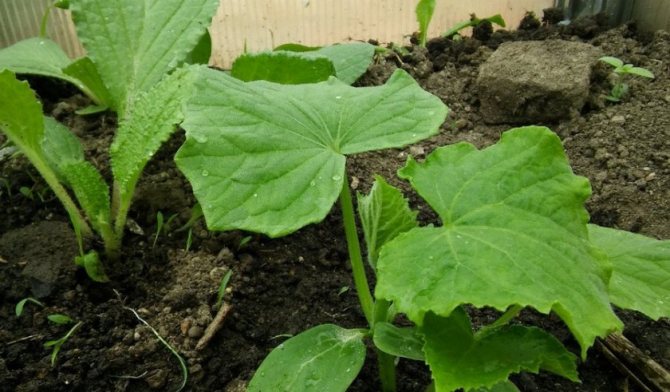

Immediately after the first digging, the soil is disinfected. A week later, under repeated digging to a depth of 30 cm, 6-10 kg of fresh manure is applied for each 1 m² (less fertilizer on the lungs, more on heavy ones). With increased acidity of the soil, instead of manure, 600 g of wood ash or 400 g of dolomite flour and 10 kg of compost are applied for each 1 m².
On heavy soils, structuring is carried out, which implies the introduction for each 1 m² of:
- 20 kg of manure;
- 10 kg of peat;
- 10 kg of sand.
It is possible to increase the efficiency of all the above-described manipulations by mulching the fertile layer. For this, sawdust, straw, sunflower husk, grass are combined in equal proportions. Lay the mulch in layers 3–5 cm high, sprinkling them with the soil. A total of 2-3 layers are made. Until spring, some of the organic matter will have time to decompose in the soil, which will increase its fertility.
In the spring
In early spring, another cultivation is carried out to a depth of 20–25 cm.
At the end of May, around the 20th, it is necessary to replenish the soil with minerals. For each 1 m², add:
- 15 g of ammonium nitrate;
- 20 g superphosphate;
- 15 g of potassium salt (unless deoxidizers in the form of dolomite flour or wood ash were used in the fall).
Important! Before planting cucumber seedlings, carefully monitor that weeds do not appear. As soon as such vegetation begins to break through, immediately remove it, otherwise the effectiveness of all preparation manipulations will decrease and the risk of pest breeding will increase.
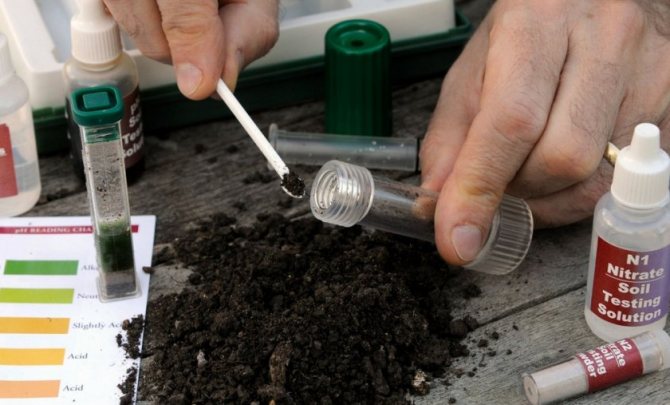

Fertilize in wet soil. If the spring is dry, the area must first be watered (20 liters of water per 1 m²). Fertilizers are applied to a depth of 10 cm. After that, the soil is leveled with a rake.
How to prepare the soil for planting cucumbers
Forming cucumbers in the greenhouse
At the end of autumn, the site is dug up. It is recommended to duplicate the digging in the spring. Manure and fertilizers are applied to the soil. For 1m2 of soil, 1 liter of manure dissolved in water is used.
Do not forget about the use of mineral fertilizers, which are applied in spring. You can enhance the effect of feeding by introducing them not at a time, but with a short interval. After that, experienced gardeners recommend cultivating and compacting with a light roller.
The best predecessors for growing cucumbers are:
- onion,
- potatoes,
- tomatoes,
- cabbage.
If we talk about plants after which it is not recommended to grow cucumbers, these include:
- watermelon,
- potatoes,
- melon,
- squash.
These plants deplete the soil, making it poor and infertile.
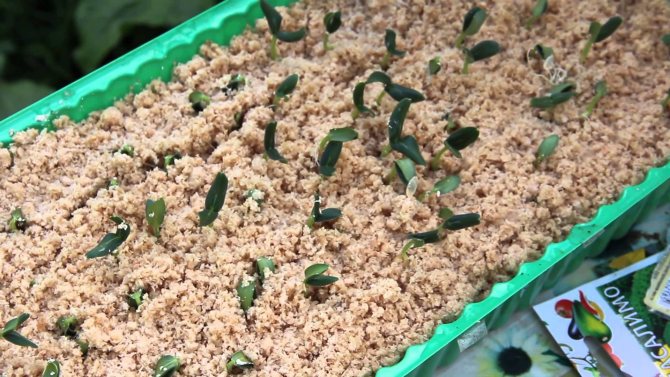

Wood sawdust is a good way to prepare the soil
Definition and structuring of different soil types
Before proceeding with the basic preparation of the soil for cucumbers, you need to put in order its mechanical composition and physical properties. To create an optimal basis, into which fertilizers will be subsequently applied to the requirements of cucumbers. The task is especially relevant when developing a new site.
To determine the type of soil, you can use a simple method that does not require special equipment. To do this, you need to take a handful of earth and slightly moisten it with water so that it does not wring out. Knead and form a lump. After that, roll a lace with a diameter of 3 mm in your palms and roll it into a solid ring.
Depending on the condition of the cord, you can determine the type of soil:
- quickly disintegrates - sandy loam;
- crushed during rolling - light loam;
- solid, but when rolled up into a ring, it disintegrates - medium loam;
- solid, but small cracks form on the ring - heavy loam;
- solid, solid ring - alumina.
The most optimal soil types for growing cucumbers. The mechanical composition of light loams does not need to be structured. In the middle loams, in the fall, manure is introduced at 5-6 kg per 1 sq. m.
Sandy loam


This type of soil warms up quickly, is characterized by intense aeration and high permeability. In addition, sandy loams are easy to process, and the transformation of organic matter into humus occurs in an accelerated mode.
The disadvantages of the soil for growing cucumbers are rapid cooling at night and the leaching of minerals from the root layer. This can be corrected by introducing fresh manure or compost from autumn to 10 kg per 1 sq. m.
These soil types are not suitable for growing cucumbers. They do not warm up well and practically do not allow air and moisture to pass through. This is culturally destructive.
When oxygen access to the roots is limited, cucumbers begin to shed their ovaries, practically do not develop and gradually dry out. Heavy soils must be loosened.
The best option is to apply fresh straw manure. This should be done in the fall, so that it has time to decompose and turn into humus. In uncultivated soils, 10-15 kg of manure are applied per square meter. m. When re-applying (recommended every 3-4 years), 5-6 kg per square meter is enough. m.
The manure is covered superficially. When deeply embedded, it does not decompose and partially turns into peat, in which bacteria necessary for plants do not develop.
Sandstone
This type of soil is not suitable for growing cucumbers. It does not retain moisture, and minerals are quickly washed out of the root layer. Heats up quickly, but also cools down during the night temperature drop.
To improve the soil by 1 sq. m. make:
- semi-rotten manure or compost 1.5-2 buckets;
- peat 1 bucket.
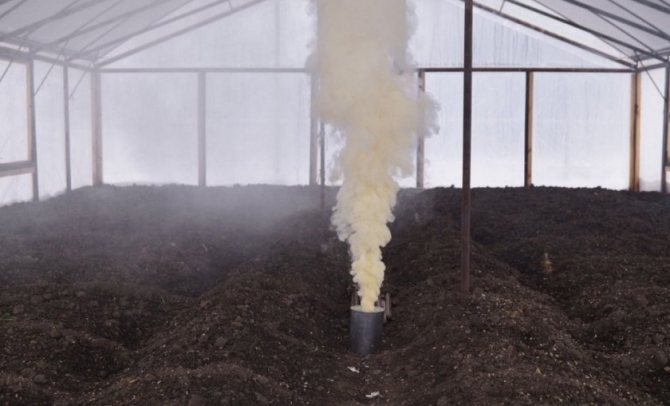

A laborious, costly, but very effective method is soil claying. To do this, in each square. m. add 1-2 buckets of powdered clay. It is combined with manure or compost. After adding any baking powder, the site is dug up. Activities are carried out for 2-3 years.
Peat boggy
In Russia, this type of soil is found in the West Siberian Plain and in its natural form is unsuitable for growing cucumbers. It is excessively moistened and fibrous, there are no conditions for decomposition of plant residues, so the peat sour strongly. The peat-boggy soil is characterized by a light brown color.
First you need to dry the area. To do this, in the spring, grooves are dug along the perimeter of the site so that the water is diverted outside the garden. By the end of summer, the site will be drained, you can begin to improve the soil.
For 1 sq. m. make:
- powdered clay 1 bucket;
- river sand 0.5 buckets;
- lime from 0.3 to 1.4 kg, depending on the acidity.
The site is dug to a depth of 20 cm. Rotted manure, humus or bird droppings are introduced 1 kg per square meter. m. More organic matter is not required.
There are many organic substances in peat, and manure in this case is used only to start the processes of its decomposition.
Work on the introduction of these components is carried out constantly from year to year. Until the soil acquires optimal physical properties that are comfortable for plants. In addition to basic fertilizers (nitrogen, phosphorus, potassium), copper and boron are added annually.
Land preparation
The preparation of the soil in the greenhouse for cucumbers in spring is carried out in several stages. It must meet certain requirements:
- good air permeability and moisture absorption.
- The fertility of the soil should be as high as possible.
Important! The best option for planting cucumbers is sod soil or humus. Humus or peat can be used as a basis.
If you plan to additionally add a complex of nutrients to the ground, the soil for cucumbers can be made from the following components:
- peat - 50%;
- humus - 30%;
- field soil - 20%.
Such a composition will have a positive effect on the yield of cucumbers.
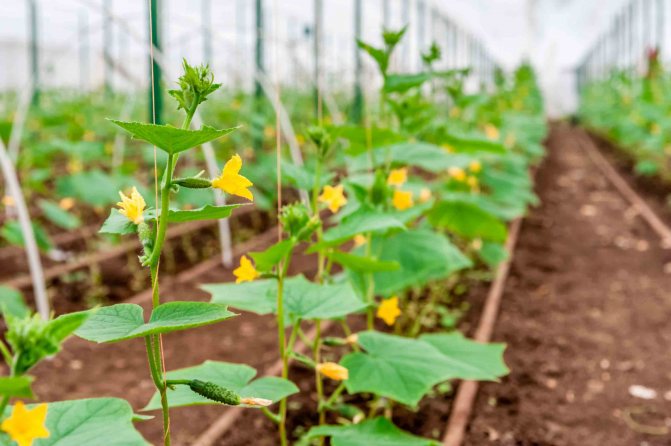

Cucumbers in the greenhouse
When preparing the soil for planting cucumbers, experienced gardeners recommend adhering to this technology:
- Clean up all plant residues and debris.
- Dig up the ground 25 - 30 days before planting the cucumbers.
- Prepare biomass.
- Form the beds.
- Plant seedlings.
- Cover the top of the soil with a layer of humus.
- Pour warm water over the soil.
Important! If cold water is used for irrigation, it is possible that the cucumbers will become sick.
If the land for cucumbers is prepared correctly, the seedlings will quickly take root, the plants will be strong and strong.
Formation of beds
The beds in the greenhouse for cucumbers are formed based on the size of the greenhouse, usually marked out in 2-3.Do not make them wider than 1 meter, so as not to obstruct access to plants, and to facilitate caring for them. To prevent washing out of the soil layer during watering, special bumpers installed along the edge of the garden will help.
The most favorable location of the beds for greenhouse plants is the direction from west to east. In this case, the cucumbers are illuminated as much as possible throughout the day.
It is important to remember that the optimal distance between shoots in a row should be 30 cm, between rows 25-30 cm. It is necessary to retreat from the walls at least 23-27 cm.
Based on this, the marking of the places of future landings is made. Many gardeners who have greenhouses at their disposal prefer to sow seeds right away in order to bypass the stage of "home" seedlings.
The second option is to plant ready-made seedlings. Cucumbers are planted in the greenhouse on April 14-22 at the age of 26-30 days, keeping the distance between the shoots. During the seedling survival period (1 week), it is advisable to increase the temperature in the greenhouse to 27 ° C, and the humidity to 86-87%.
Cucumbers are a semi-melon crop, so both in the greenhouse and in the open field they need high raised beds. It is better to form them already in the fall, so that in the constructed embankments it would be able to form its own microclimate and its own chemo-bio-environment. Remember that the topsoil should be well mixed and loose. Try to lay the beds so that organic additives (especially manure) do not lie in the open air, carefully sprinkle them with earth. Pull the wire under the ceiling of the greenhouse, to which you will tie the cucumber vines.
Predecessors and siderates
In the process of preparing high-quality soil, you need to take into account which plants were grown in the greenhouse last season. A good harvest can be obtained if the crop rotation is observed in the garden plot. Cucumbers need to be planted in the area where they grew before:
- carrots and cabbage;
- garlic and onions;
- bell peppers and tomatoes;
- wheatgrass and cornflowers;
- burdock and bindweed;
- winter wheat and spicy perennial herbs.
Attention!
It is not worth growing cucumbers constantly in one place for more than 3 years.
It is not advised to plant cucumbers in a place where watermelons, zucchini, pumpkins were previously grown. White mustard is considered a good green manure. After a month, it is mowed and mixed with the ground.
Liming
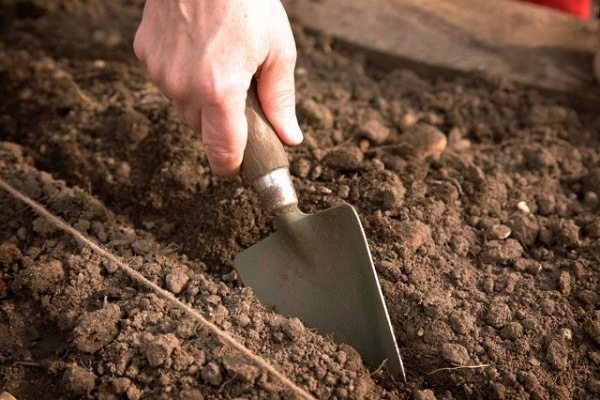

To lower the acidity index of the soil, you can use:
- dolomite flour;
- wood ash;
- cement dust;
- bone meal;
- chalk;
- limestone.
The level of acidity and the texture of the soil affects how much substance will have to be applied. Cucumbers are among those crops that respond negatively to liming. It is recommended to introduce any of the above even when predecessor plants are growing in the garden. After application, the topsoil must be dug up.
Attention!
The second liming can be carried out only after 6 years.
Using top dressing
It may be interesting Features of processing gooseberries in the spring from pests and diseases Cyclomenia-flower: unusual beauty with proper care Diseases of cucumbers in a greenhouse and their treatment.
An excellent top dressing for cucumbers is last year's rotted manure. It is necessary to warm it up 4-5 days before it is to be transferred to the greenhouse, interrupting with a pitchfork. You can increase the temperature of organic fertilizer by adding to it:
- very hot stones;
- quicklime;
- hot water.
Manure is placed in the greenhouse after it has warmed up to 65 ° C. The layer of the bookmark is 0.5 cm. Evaporation will continue for several days. During this time, organic matter will naturally settle, make the soil more fertile and richer. On top of the manure, a 10 cm layer of soil should be poured with a mixture of humus, peat and sod, or with compost.
Regulation of acidity
Sour soil is typical for low-lying areas with stagnant spring water.Acidity can also increase after seasons of high rainfall, which washes away calcium and magnesium. Hydrogen ions begin to predominate in soil particles, increasing its acidity.
In such areas, plantain, wild rosemary, horsetail, veronica and sorrel grow rapidly. When digging up the soil at a depth of 10-15 cm, you can find a layer of light color, reminiscent of ash.
The easiest and most inexpensive way to determine the acidity of a soil is to use litmus paper. It can be purchased at any garden store and drugstore.
To determine the acidity of the soil, mix a semi-liquid solution from soil and distilled water, immerse a strip of litmus paper in it for 2-3 seconds. To calculate the acidity values, it is compared with the supplied color scale.
Calcium carbonate is used to reduce the acidity of the soil. It is found in ground limestone, chalk, cement dust, wood ash, dolomite and bone meal.
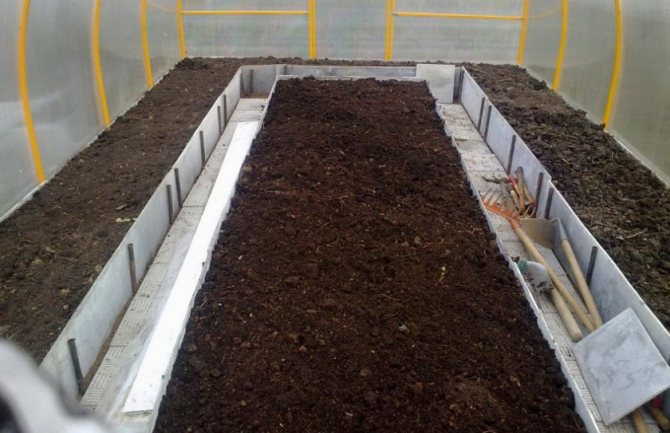

For the primary regulation of acidity, it is better to use ground limestone. The rate of its introduction per 1 sq. m. for different types of soil (pH {amp} lt; 4.5 / pH 4.6-6.0):
- sandy 400/100 g;
- sandy loam 600/150 g;
- loamy 800/350 g;
- alumina 1100/500 g;
- peat-boggy 1400/300 g.
Cucumbers are very sensitive to liming, therefore, it is better to carry out measures to reduce the acidity of the soil under the previous crop. In extreme cases - in the fall.
Later, to maintain acidity at the required level, wood ash is used, which also serves as a good fertilizer.
Step-by-step instructions for autumn soil preparation in a greenhouse
Greenhouse preparation begins with removing the remnants of previous plantings and removing debris. The sooner this is done after harvesting, the lower the risk of various diseases.
Assessment of soil acidity level
If the gardener does not know the acidity level of the soil in the greenhouse, then it can be measured using laboratory tests or independently, with his own hands (using garden probes - indicator sticks).
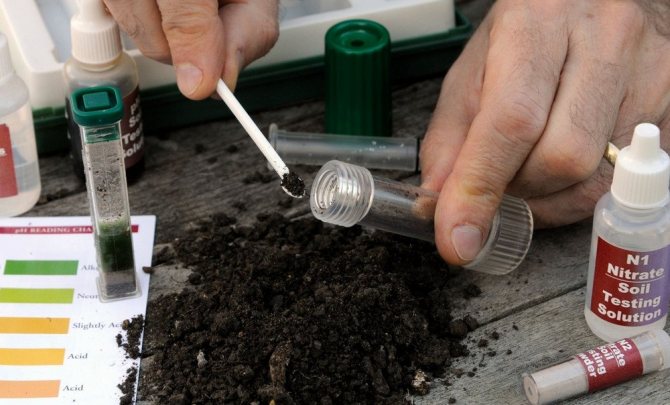

Since cucumbers love slightly acidic or neutral soils, it is often necessary to additionally liming the beds if the natural acidity level exceeds the specified norms.
Did you know? In Kievan Rus, a popular dish was "black ear" - meat boiled in cucumber pickle with spices.
Liming can be carried out using various methods:
- simply sprinkling quicklime 200 g per 1 m²;
- using dolomite flour in the same proportions;
- using wood ash (at the rate of 300-350 g per 1 m²).
Determination of the mechanical composition of the soil
Many gardeners determine the type of soil based on its color. However, such a method, from a scientific point of view, is considered erroneous, since it is easy to confuse some similar-looking soils. The most accurate result in this case will be given only by laboratory tests, however, there is also a proven method at home.
According to him, you need to carry out the following manipulations:
- The soil sample is moistened.
- After it is kneaded like dough.
- Then the soil is rolled into a ball, which is then rolled into a cord or "sausage" no thicker than 3 mm.
- The resulting "product" is then tried to roll into a ring.


Indicators for determining the mechanical composition of the soil.
After that, the type of soil is determined:
- soils with a high sand content do not form balls or cords;
- sandy loam rolls into a ball, but it will not work to make a cord out of it;
- light loams form a fragile ring that falls apart from the slightest movement;
- an elastic cord is obtained from medium and heavy loam, it can be rolled into a ring, but it will immediately be covered with cracks;
- and only clay will make a perfectly smooth ring.
Cucumbers prefer light to medium loamy areas. If the soil available in the greenhouse does not meet these criteria, then sand will help to correct the situation.In the fall, you can also equip the drainage system with gravel and medium-sized branches, twigs.
Disinfection
The next stage in the preparation of the greenhouse is disinfection, during which the soil is disinfected, as well as the metal, wood and glass components of the structure. Soil processing is done with copper sulfate, spraying its solution to a depth of 5–7 cm.
Important! When disinfecting a greenhouse, it is worth remembering personal protective equipment. Surface and soil treatment should be carried out only with gloves and a mask, avoiding being in an unventilated room for more than 10 minutes.
To disinfect structures, bleach is used (300 g is diluted in 10 liters of water and allowed to brew for 4–5 hours). The resulting liquid is sprayed onto glasses and crossbeams, and the resulting sediment is showered on wooden components and the cracks between them. When the greenhouse dries well, you can carry out additional processing with sulfur blocks at the rate of 50 g per 1 m³.
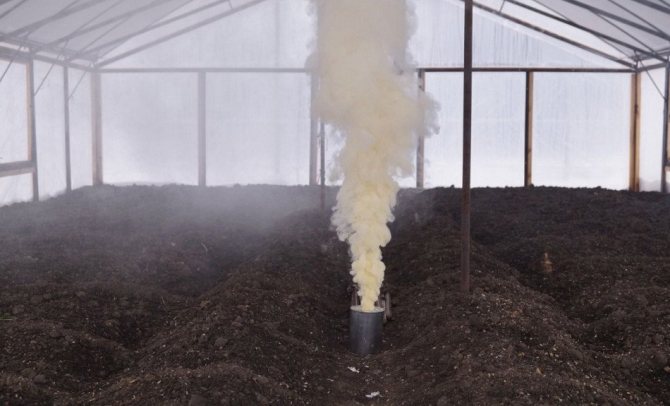

Checkers set fire to and close the room for 10-15 minutes. Smoke penetrates into those cracks and places where the solution or powder does not reach, so the treatment will have the maximum effect. If a spider mite has wound up in the greenhouse, then you need to take a double portion of sulfur.
Composition and properties
Cucumbers love fertile, humus-rich soil. It can be loam or sandy loam soil. If there is only alumina on the site, the situation will be corrected by the introduction of sand (a pair of buckets is enough for 1 sq. M.). In addition, the acidity level plays an important role.
For a rich harvest, a neutral pH is required. Slightly acidic soil is also acceptable. But strongly acidified soils require preliminary liming. The dosage of lime application is determined by the actual acidity level, usually from 250 to 550 g per sq. m.
Note. Reduce acidity often with chalk and wood ash.
An ideal soil for cucumbers should contain:
- Mullein. Natural organic raw materials contain a lot of nitrogen, which gives the carbon dioxide that cucumbers need. In addition, fresh raw materials create a greenhouse effect in the garden, which protects heat-loving plants from temperature fluctuations.
- Sawdust. It is a natural soil loosening agent. Microorganisms that decompose wood actively consume nitrogen, which is especially important in case of an overdose of this macronutrient.
- Dernina. Contains humus, a small amount of nitrogen, organic matter. Clover turf is especially good, with a width of 6 cm. Before laying in cucumber beds, this natural organic matter must be well peeled.
- Humus. The main source of nutrients for cucumbers, since it contains all the elements necessary for the culture, and in a form that is convenient for assimilation. If not, it is replaced with rotted compost.
- Sand. Perfectly loosens the soil, acts as an excellent drainage material.
- Peat. Allows you to increase the percentage of soil nutrition, improves its moisture capacity, air permeability.
Soil heating
Naturally, the soil in the greenhouse warms up only by June, depending on the region. In order to plant cucumbers in early spring, the greenhouse should be heated artificially.
There are three options for artificial heating of the greenhouse:
- using electrical appliances;
- water heating;
- due to warm beds.
Electrical appliances - heaters, special electrical plates, electrical cables. The advantage of this heating method is that it is possible to adjust the heat supply power; the ability to heat the greenhouse even in winter. But there are two drawbacks: the high cost of equipment and installation.
Water heating is used with the use of special pipes made of polymer material, which are laid under the ground. Heating takes place due to hot water that flows through the pipes.
Warm beds. This heating method is the most economical. The soil is heated by natural biofuel, laid in the lower layer of the ridge.The remains of plants, cardboard, manure, sawdust are taken as a filler. Heat is released during the decay process and is capable of heating the soil for two months.
Cucumber Care - Watering
Cucumbers need regular watering. The best time for him is the afternoon. It is better to water from a watering can in small doses. The water should first be warmed up in the sun. Watering with cold water can cause various plant diseases. The irrigation rate depends on the weather conditions, the condition of the plants and the composition of the soil.
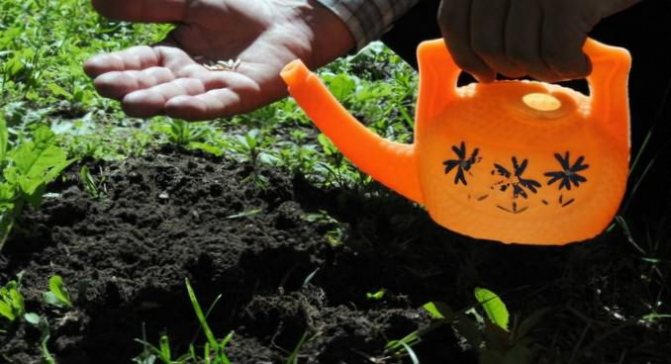

When flowering begins, watering is stopped for a while. In a slightly increased volume, it is renewed at the beginning of fruiting.
Tips from experienced gardeners
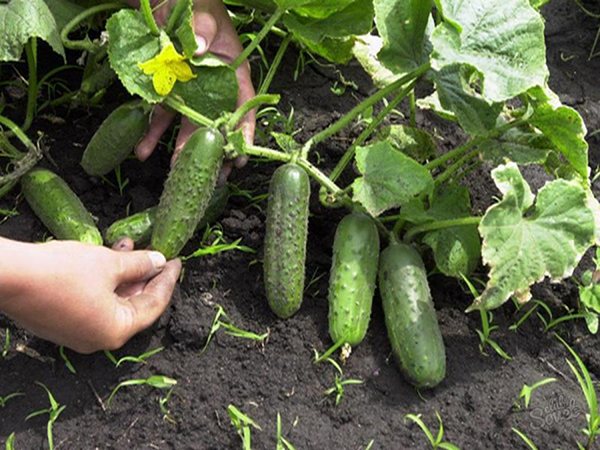

- In the spring, it is advisable to replace the greenhouse soil with a new soil mixture. This allows you to remove pathogenic microflora and pests from the greenhouse, and also makes it possible to make the soil looser and more fertile.
- If possible, the greenhouse is rearranged to a new place, this will eliminate the need to replace the soil with a new one.
- When painting heating pipes in a greenhouse, it is not recommended to use oil paint, as it impairs heat transfer.
- When washing the greenhouse, potassium permanganate or Bordeaux liquid (3-5%) can be added to the water. Bordeaux liquid will protect the greenhouse from rust, rot, late blight, scab.
- When using soapy water when washing the metal parts of the greenhouse, the soap should not get on the ground!
- You can increase the yield of cucumbers by increasing the level of carbon dioxide in the air. For this, a barrel is installed in an enclosed space, half filled with manure. Water is added to the top. The mixture in the barrel is stirred daily. After a few days, it begins to ferment and carbon dioxide is released. In the future, the contents are used as top dressing.


